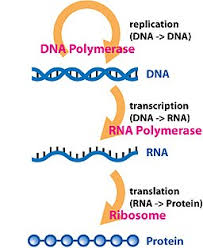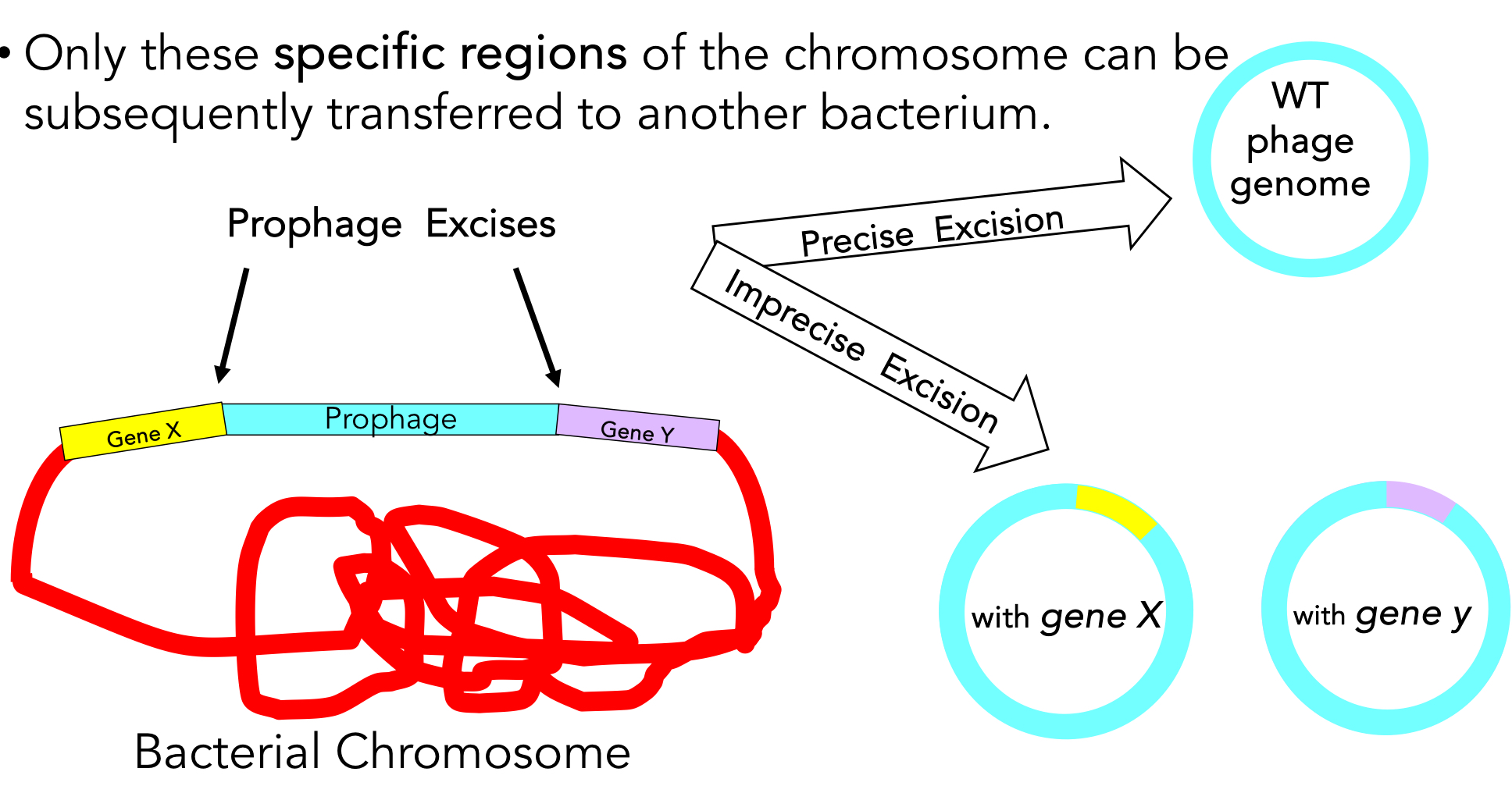3.1 Infectious diseases bacterial genetics
1/49
There's no tags or description
Looks like no tags are added yet.
Name | Mastery | Learn | Test | Matching | Spaced |
|---|
No study sessions yet.
50 Terms
central dogma
flow of genetic material DNA to RNA

explain bacterial plasmid uptake
aka transformation; bacteria acquire and incorporate foreign DNA (such as plasmids) from their environment
where does a promoter bind?
at the -35 or -10 positions of DNA sequence of upstream of the gene, recognized by RNA polymerase for binding too
define codon
set of three nucleotides in the mRNA that are read by ribosomes
what is the start codon?
methionine AUG
ribosome starts making protein here
what are the three stop codons?
UAA, UAG, UGA
ribosome falls off the message and protein synthesis is terminated
define mutation
any change in the DNA that makes it different than WT
define genotype
genetic makeup, DNA sequence
define phenotype
physical trait; look or behave
a change in (BLANK) can lead to a change in (BLANK)
genotype, phenotype
list the 8 bacterial phenotypes:
motile
nonmotile
encapsulated
acid producing
Lac-
smooth colonies
yellow colonies
rough colonies
explain Lac⁻ mutant
bacteria cannot digest lactose so lactose crosses the membrane through the lactose permease (coded by the lacY gene) and is then broken down by β-Galactosidase (coded by the lacZ gene) into glucose
both lac Z and lac Y genes (Z more upstream) are controlled by a single upstream promoter, lac promoter making them an operon
genotype of lac mutant?
lacY⁻
phenotype of lac mutant?
Lac⁻
can a Lac⁻ mutant grow on lactose as a carbon source?
no!
What gene can produce a Lac⁻ mutant?
mutations in lacZ or lacY gene! you can achieve the same phenotype with different genotypes
five main types of mutations:
base sub
deletion
insertion
frameshift
null
define base substitution and the three categories:
a change from one nucleotide to another; silent, missense, nonsense
define silent mutation
change in codon that does NOT change the amino acid
change in DNA → change in mRNA → no change in protein
define missense mutation
change in codon so it encodes a different amino acid
change in DNA → change in mRNA → change in protein
define nonsense mutation
change codon so it becomes a stop codon
change in DNA and mRNA
define deletion mutation
removal of DNA (could be small or entire genes)
define insertion mutation
add piece of DNA to gene, many large insertions caused by transposable elements (viruses or mobile DNA sequences called transposons)
define frameshift mutations
deletion or addition of nucleotides not divisible by three
change in DNA → change in mRNA → change in all amino acids at and/or after point of mutation
null mutation
mutation completely eliminates gene function
in bacteria mutations may result in a change of ability to:
utilize a carbons source, such as lactose
synthesize an aa
resist an Ab
how do mutations occur?
spontaneously (error in repli)
exposure to mutagenic agents
UV light
NaNO3 metabolized to HNO2 nitrous acid which deaminates bases altering their base pairing
C is deamin → U, which bp w A and not G
leads to U bp w A and therefor T bp w A
what divides faster bacteria or eukaryotes?
bacteria!
two pathways to acquire genetic changes?
vertical gene transfer: parent to offspring
horizontal gene transfer (HGT)
what are the three types of HGT?
transformation, transduction, conjugation
new DNA from outside cell, from other cells, direct cell-cell and maintained through VGT
define transformation
new genetic material acquired from other cells
competent (able to import DNA) bacterial cell acquired new genetic material from its enviro
historical explanation of transformation:
live smooth colonies (smooth/glistening bc of sugar capsule making them unable to be phagocytosed) kill mice. live rough colonies do not kill mice.
inject live rough and dead smooth, the live rough transform into live smooth as the uptake the free lysed contents of the dead smooth
explain pili transformation
bateria use pili to fish for and grab DNA
free DNA in enviro are sensitive to …
… DNase, an enzyme that digests DNA and inhibits transformation
imported DNA fragments from transformation are (BLANK) than a bacterial chromosome
SMALLER, 1-10 genes
define transduction
intro DNA from outside the cell
bacteriophage transfers genetic material from one bacterium to another
define bacteriophage
viruses that infect bacteria - virulent aka “lytic” growth cycle
define conjugation
DNA can be maintained and propagated in subsequent progeny through VGT
what are the two types of bacteriophages?
lytic phages: repli inside the cell and subsequently kill (lyse) the host cell
lysogenic/temperate phages: integrate their phage genome into the bacterial chromosome (as prophage)
explain lytic phage generalized transduction:
during repli the host DNA degraded
random piece of host chromosome can be packaged by phages
any region of chromosome can be transferred
phage particles carrying host DNA can subsequently infect another bacteria
the idea: integrate to get taken up and kill other bacteria
explain specialized transduction by lysogenic phages:
region of bacteria chromosome directly adjacent to prophage may be accidentally packaged during excision
only these specific regions can be transferred to another bacterium

differences btwn the types of HGT
feature | transformation | transduction | conjugation |
Definition | Uptake of free DNA from the environment. | Transfer of DNA via a bacteriophage. | Direct transfer of DNA via cell-to-cell contact. |
DNA Source | Free/naked DNA. | DNA packaged in a virus. | Plasmid or chromosomal DNA from donor. |
Mediated by | Competence factors in bacteria. | Bacteriophages (viruses). | Sex pilus and conjugative plasmids. |
Requirement | Competent bacterial cells. | Bacterial infection by a phage. | F+ or Hfr donor cell; direct contact. |
Type of DNA | Plasmid or chromosomal fragments. | Bacterial genes or viral DNA. | Typically plasmid (e.g., F plasmid). |
Example | Uptake of antibiotic resistance genes. | Phage-mediated gene transfer (e.g., λ). | Transfer of F plasmid in E. coli. |
could the incoming DNA from transformation or transduction be maintained in the cell?
yes, there is homology
homologous recombination:
genetic process where two DNA molecules exchange genetic material by aligning and crossing over at regions of high sequence similarity
incoming DNA (made into ssDNA) lined up to homologous DNA region by RecA
double recombo result in acquisition of new gene in one strand of chromosome
recipient incorporate this new gene in one of the products of a round of chromosomal DNA repli (completely integrate; may get new ability, Ab resistance, virulence factor, new enzyme)
what are plasmids?
non chromosomal DNA
definition and types of replicons:
DNA elements capable of self-repli, chromosomes and plasmids
what two things do you need to be a replicon?
ORI: site/sequence in DNA where rep protein binds
rep gene: bind to ORI to initiate DNA repli
how do bacteria acquire new plasmids?
bacteria can pick up free DNA plasmids by transformation
some phages can transduce a whole plasmid
plasmids can be transferred from one bacterium to another through conjugation
what is conjugation:
process by which genetic material is transferred from one bacterium to another through direct contact; and give donor ability to transfer plasmid to other bacterial cells (mating)
unidirectional w donor and recipient
DNA transferred as a plasmid (distinct from chromosome)
plasmids carry special conjugation gene (tra gene) and are called conjugative plasmids
Conjugation summary
donor synthesizes conjugative or sex pilus, tra genes found on conjugative plasmid
donor sex pilus attach to recipient cell
upon contact, donor retracts sex pilus and pore formed btwn two cells, allowing transfer of ss copy of plasmid into recipient cell
ss copy of conjugative plasmid circularizes and repli completes complementary strand. upon acquiring this conjugative plasmid the recipient cell has become a new donor